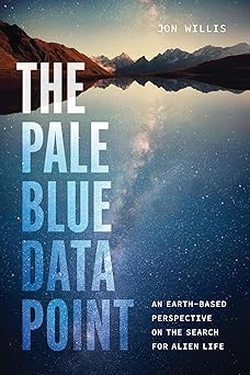Centauri Dreams
Imagining and Planning Interstellar Exploration
New Horizons: Checking in on Approach Operations
Here’s another, wider look at New Horizons’ view of Ultima Thule (MU69), its next target, which we first saw in late August, though the image was acquired at mid-month. I like this view because it gets across just what a tricky acquisition this was. Look at the background star-field! Consider that Ultima is still 100 times fainter than Pluto as seen from Earth, making it about a million times fainter than a naked eye object. LORRI, the spacecraft’s Long Range Reconnaissance Imager, once again demonstrates its key role in the mission.
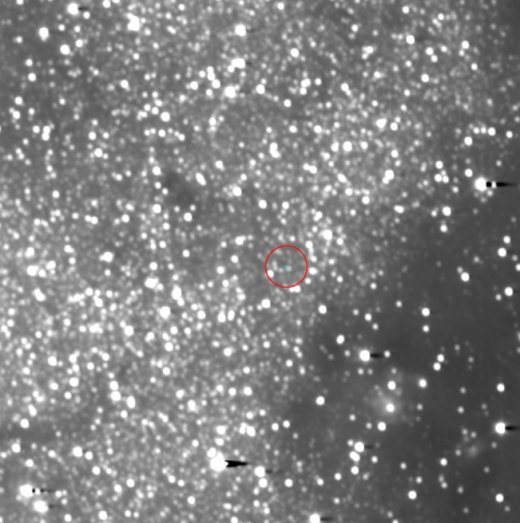
Image: New Horizons spotted Ultima Thule for the first time on August 16, near the center of the red circle in this LORRI image of the dense Milky Way star field where Ultima lies. Credit: JHU/APL.
Getting the image as early as it did was something of a coup for New Horizons, this being the first attempt, made just after the spacecraft transitioned from spin-stabilized mode (during cruise) to pre-flyby mode, which allows its cameras and other instruments to point as needed. According to New Horizons’ PI Alan Stern, the detection images were returned to Earth on August 18-19, where they received the necessary processing to remove artifacts. Says Stern:
Scientists on our team in Maryland, Arizona, and Colorado jumped right onto those data, carefully processing them to remove background stars and other artifacts — and out popped Ultima, a faint beacon, dead ahead, in just the very pixel our navigation crew had predicted it would show up!
Useful work indeed, allowing regular imaging from the spacecraft to refine New Horizons’ course. We learn in Stern’s latest report that the team plans to execute a course correction on October 3, affecting the craft’s trajectory by about 3 meters per second, so the team is already fine-tuning approach and arrival parameters. As part of future course refinements, remember that we now have data from the occultations of a background star by Ultima that occurred on August 3-4, events that were observed by teams in Senegal and Colombia. For more on this and the previous occultation work in Patagonia, see On to Ultima Thule.
We can anticipate a full update from mission scientists at the 50th annual meeting of the Division for Planetary Sciences, coming up in late October in Knoxville, TN, where new results from Pluto/Charon will also be discussed. Right now, the search for collision hazards near Ultima continues as does navigation imaging of the target, which could well lead to future course-corrections. Although no hazardous debris has yet turned up in the occultation data, November and December will see the LORRI instrument scanning the target intensely at closer range. And Ultima Thule isn’t the only KBO in the mix, as Stern reports:
New Horizons will collect data on a half-dozen other Kuiper Belt objects and the plasma and dust environment way out there in the Kuiper Belt, nearly 4 billion miles from Earth. Also, our flight team will be finalizing the software loads to drive the spacecraft’s close-up flyby observations of Ultima and its environment, from geology to composition, to searches for moons, rings and any atmosphere Ultima may sport.
And for another sense of scale, the image below views New Horizons’ current position in relation to the rest of the Solar System. Now would be a good time to read, if you haven’t already, Stern and David Grinspoon’s Chasing New Horizons (Picador, 2018). In the book, the authors discuss how critical pre-flyby planning and maneuvers were to get the spacecraft to arrive at closest approach to Pluto/Charon within the tight window (9 minutes!) necessary for all the spacecraft’s programmed pointing maneuvers to center its targets.
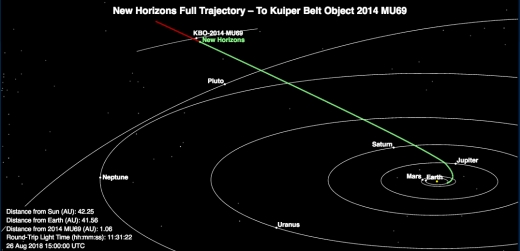
Image: New Horizons has crossed almost all of the 1.6 billion kilometers (1 billion miles) separating the July 14, 2015, flyby of Pluto and the upcoming January 1, 2019, flyby of the Kuiper Belt object (KBO) nicknamed Ultima Thule. Credit: JHU/APL.
What Stern tells Grinspoon here is just as germane to the approach to Ultima Thule:
Much of how New Horizons achieved this goal was done with careful optical navigation and rocket-engine firings that the spacecraft performed to home in on the closest-approach time. But mathematical analysis had shown that this alone might not be good enough to guarantee arrival in the critical plus-or-minus 540 second window. So the spacecraft’s engineers at APL also built in some clever software to correct for any remaining timing errors once it was too late to fire the engines.
The importance of the optical information is likewise clear:
As the spacecraft approached Pluto, every day the optical navigation team used new images to determine just how far off the closest approach timing was going to be, and then calculated the timing knowledge update needed to correct for that. Concurrently, Leslie Young and her encounter planning team used sophisticated software tools to generate a ‘science consequences report,’ in which each close-approach observation was simulated for the newly predicted timing error to determine, assuming no correction was made, which would succeed and which would fail.
For the Ultima Thule encounter, the New Horizons team is conducting mission simulations and working through procedures for over 250 possible spacecraft contingencies should problems arise (as part of that effort, new fault protection software has already been uploaded). With the journey from Pluto/Charon to the KBO now 90 percent complete, we can look forward to the New Year’s Eve flyby, followed by further data acquisition from the Kuiper Belt beyond.

Transiting Debris around a White Dwarf
Who among us hasn’t speculated about the ultimate fate of the Solar System? The thought of our Sun growing into a vast red giant has preoccupied writers and readers since the days when H. G. Wells so memorably captured a far future scene through the eyes of his Time Traveler. And what a scene that was:
“I cannot convey the sense of abominable desolation that hung over the world. The red eastern sky, the northward blackness, the salt dead sea, the stony beach crawling with these foul, slow-stirring monsters, the uniform poisonous-looking green of the lichenous plants, the thin air that hurts one’s lungs: all contributed to an appalling effect. I moved on a hundred years, and there was the same red sun—a little larger, a little duller—the same dying sea, the same chill air, and the same crowd of earthy crustacea creeping in and out among the green weed and the red rocks. And in the westward sky, I saw a curved pale line like a vast new moon.”
Wells was working on a different timescale than we now know to be the case, but we track his protagonist in leaps of a thousand years each as he moves into the future, “…drawn on by the mystery of the earth’s fate, watching with a strange fascination the sun grow larger and duller in the westward sky…” He catches the transit of a planet across the swollen Sun but doesn’t know which it is — so distorted appears the Solar System in the sky above that he wonders if Mercury is not near the Earth in this era, an inner planet imperiled by its own monstrous star.
It’s lively stuff, and demands translation into our current understanding of stellar evolution: What does happen to our system’s planets when the Sun expands to red giant stage? One way of looking into this is to see what we can find around white dwarf stars, the ultimate destinations of stars in the Sun’s mass range after the red giant era ends. At this point, our star will have lost its outer layers, leaving only a comparatively tiny, dense core.
Back in 2015, Andrew Vanderburg (Harvard-Smithsonian Center for Astrophysics) and colleagues published their findings about the white dwarf WD 1145+017, located in Virgo about 570 light years from Earth. The researchers were working with data from the rejuvenated K2 mission, which revealed that light from the star was periodically dimmed by a series of objects. The rocky bodies responsible were, the paper suggested, disintegrating, leaving traces of calcium, iron and aluminium on the white dwarf’s surface.
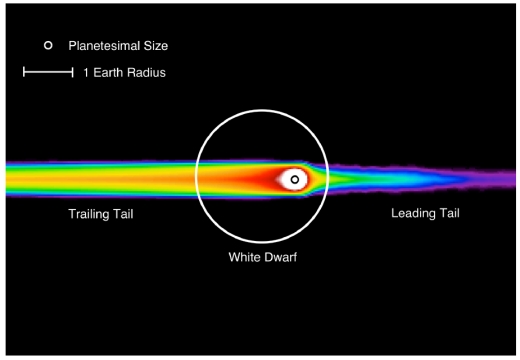
Image: A schematic of the trailing and leading cometary tails from the disintegrating planetesimal compared to the White Dwarf host size. Figure from Vanderburg et al. (2015).
Now we have further insights into the same star from a team led by Paula Izquierdo of the University of La Laguna, Spain, who went to work on the white dwarf using the Gran Telescopio Canarias (GTC) and the Liverpool Telescope (LT). The method was fast optical spectrophotometry and photometry, analyzing the acquired spectra as a function of wavelength. With data from both telescopes, the objects around WD 1145+017 have been captured making two deep transits.
What emerges is that there is a lengthy period between the beginning of the transits and their end, one that is consistent, according to the researchers, with a comet-like tail. This fits with the earlier work of Vanderburg and team, who believed they were seeing the signatures of dust and gas clouds being produced from solid fragments on a roughly 4.5 hour orbital period. Moreover, there is a noteworthy timing feature that the paper explains, with an interesting comparison:
We note in passing that the six times of transit minimum are roughly equally spaced in time, with an average separation of 6.2±1.1 min. The nearly equal spacing of these bodies is reminiscent of the string of fragments of comet Shoemaker-Levy 9 (Weaver et al. 1994).
The famous ‘string of pearls’ comet may thus have an analogue around a distant white dwarf, or else, says the paper, we are seeing evidence of a dense debris cloud, or multiple clouds, extending 120° in azimuth. The authors find that WD 1145+017 has a mass of 0.63 ± 0.05 Solar masses and a cooling age of 224 million years, plus or minus 30 Myr. The ‘cooling age’ is a reference to the white dwarf’s age as a degenerate star; it does not, in other words, include its long span as a main sequence star and the red giant phase that would have followed it.
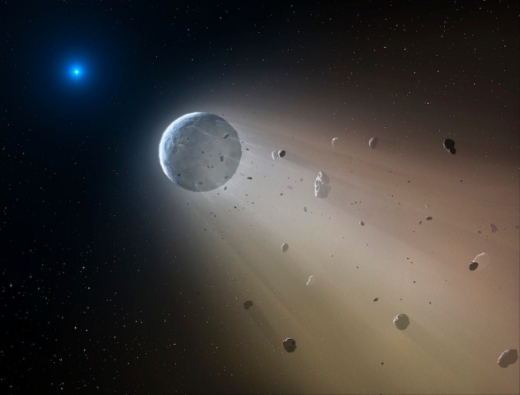
Image: The K2 mission spotted a disintegrating planet swirling around a white dwarf star. Credit: Mark Garlick.
Is this the fate of our own Solar System, to be shredded into clouds of debris around a slowly cooling white dwarf? For decades, we’ve known that the surfaces of some white dwarfs are rich in metals, possible debris from the original system. Now we can push that speculation further, in this case aided by useful transit signatures. This is a lengthy process, as the authors of the Izquierdo study note in relation to WD 1145+017, but one with a clear path for future work:
The decrease in the strength of the circumstellar line provides no information on the relative location of gas and dust along the line-of-sight towards the white dwarf. Time-resolved spectroscopy with a higher signal-to-noise ratio has the potential to provide further insight into the geometry of the gas and dust within WD 1145+017.
The paper is Izquierdo et al., “Fast spectrophotometry of WD 1145+017,” Monthly Notices of the Royal Astronomical Society (24 August 2018). Abstract. The Vanderberg paper is “A disintegrating minor planet transiting a white dwarf,” Nature 526 (22 October 2015) 546-549 (abstract).

‘Rogue’ Planet Population in the Galaxy
We’ve recently looked at gas giant planet formation, and specifically the stages in which Jupiter seems to have formed — this is the work of Thomas Kruijer (University of Münster) and colleagues as summarized in A Three Part Model for Jupiter’s Formation. Whether or not the details of Kruijer and team’s model are correct, it seems evident that gas giants must form quickly, based on current theories. These involve the formation of a large solid core, with gas accretion building up a thick atmosphere at a time when the disk around the parent star is still rich in materials.
In this thinking, planets like the Earth come along much later than the gas giants that are the first to form. Get a few million years into the evolution of a stellar system and there should be evidence of a gas giant, if one is going to form, but terrestrial worlds can take up to 100 million years to emerge. This has captured the interest of Nader Haghighipour (University of Hawaii), whose work was presented at the General Assembly of the IAU meeting in Vienna.
Haghighipour is interested in so-called ‘rogue’ planets, and his focus is on early system formation as a way of exploring their population in the galaxy. Bruce Dorminey has a good entry on this in Forbes, recounting the basics of Haghighipour’s statistical study, one that involved 500 simulations of terrestrial planet formation, including multiple models.
What gets intriguing here is that Haghighipour believes most stellar systems wouldn’t be very good at ejecting planets out of the parent system. This has bearing, of course, on the question of how many rogue planets, free-wandering worlds without a star, might be out there.
It is an issue that is a long, long way from being resolved. Without the reflected light of a primary, such planets are extremely hard to detect except through gravitational lensing, where the light of a background star may be affected by the curvature of spacetime in the presence of a gravitational well, the distortion giving us information about the intermediate object. Used in the exoplanet hunt, gravitational microlensing allows us to spot planets down to rocky, terrestrial-sized worlds around stars thousands of light years away, with the significant limitation that such observations are one-off affairs. You can’t realign the stars to do a second run.
The Microlensing Observations in Astrophysics (MOA) survey, based in New Zealand, as well as the Optical Gravitational Lensing Experiment (OGLE), using a 1.3 meter telescope in Chile, have found a small number of possible ‘rogue’ planets of roughly Jupiter’s mass. A 2011 paper made the case that given microlensing probabilities — and taking into account the efficiency of the equipment at these installations and the rate of such lensing — there could be as many rogue planets in the Milky Way as there are stars. Louis Strigari (Stanford University) has likewise estimated high numbers of rogue planets ranging from Ceres-size on up to gas giants.
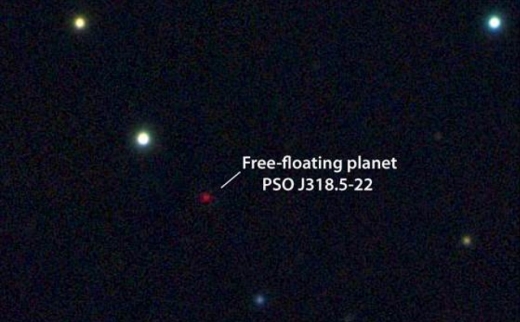
Image: One apparent free-floating planet turned up in a search for brown dwarfs. This multicolor image is from the Pan-STARRS1 telescope, showing PSO J318.5-22, in the constellation of Capricornus. The planet is extremely cold and faint, about 100 billion times fainter in optical light than the planet Venus. Most of its energy is emitted at infrared wavelengths. The image is 125 arcseconds on a side. Credit: N. Metcalfe & Pan-STARRS 1 Science Consortium.
But at the same IAU meeting, according to Dorminey’s report, Yutong Shan (Harvard University) presented evidence from the K2 mission, using data from both the revived Kepler and ground-based surveys. Shan’s team was hunting for free-floating planets, but while they found candidates, none were conclusive — in other words, the detections may be brown dwarfs.
For his part, Nader Haghighipour believes that there aren’t as many rogue planets to find as some believe. The reason: It’s when the protoplanetary disk is seething with youthful energies that planets are likely to be ejected — few terrestrial worlds available then — and only 1-2 percent of these would leave the system. Shan’s Kepler study is ongoing, but as Dorminey notes, the early results seem to support Haghighipour in his doubts over rogue planet ejections.
But we are early in this work. Let me also draw your attention to work at the University of Oklahoma from Xinyu Dai and Eduardo Guerras. Working with data from the Chandra X-Ray Observatory and microlensing models of their own design, the duo have been studying the black hole at the center of quasar RX J1131-1231. Here we have a background quasar being lensed by the foreground black hole, and Dai and Guerras show that these emissions near the Schwarzschild radius of the black hole can be affected by planets nearby in its galaxy.
What we get here is another ‘rough cut’ at rogue planets, this time in another galaxy, and in it, the authors calculate about 2000 objects per main sequence star, in sizes ranging from the Moon to Jupiter. Dai and Guerras, in other words, come up with numbers that come closer to supporting Strigari than Haghighipour. All of which makes a strong case that on the subject of rogue planets in this or any galaxy, what we still don’t know vastly outweighs what we do.
The microlensing paper mentioned above is Sumi et al., “Unbound or distant planetary mass population detected by gravitational microlensing,” Nature 473 (19 May 2011), 349-352 (abstract). The Strigari paper is “Nomads of the Galaxy” Monthly Notices of the Royal Astronomical Society Vol. 423, Issue 2 (21 June 2012 – abstract). The paper on RX J1131-1231 is Xinyu Dai & Eduardo Guerras, “Probing Planets in Extragalactic Galaxies Using Quasar Microlensing,” Astrophysical Journal Letters Vol. 853, No. 2 (2 February 2018). Abstract.

Finding Jupiter’s Water
One of the memorable things about 1995 (and this was also the year of the first detection of an exoplanet around a main sequence star) was the release of the Galileo spacecraft’s descent probe. Dive into that howling maelstrom, it would seem, and instant obliteration should follow. But the probe had been designed with a heavy duty heat shield to protect it during its journey. It kept transmitting after scorching its way into Jupiter’s atmosphere at 47 kilometers per second, 30 km/sec faster than Voyager 1. The probe returned data for fully 58 minutes before its demise.
Here’s how two science fiction novelists handle a descent into the Jovian clouds:
Slowly, the fine fretwork of the ammonia cirrus clouds above him became obscured by brown and salmon layers of intervening chemistry, the air stained a nicotine-coloured haze of complex carbon molecules. Soon it was warmer than a summer’s day out there, and already the gondola was enduring more than ten atmospheres of pressure, the structure making slight creaking sounds as it absorbed the mounting forces. Falcon eyed the hull around him with a certain wariness, trusting that the Kon-Tiki‘s molecular-scale refurbishments had been as thorough as claimed.
A certain wariness seems justified. And this:
Overhead, the sky was darkening through shades of purple. This was not the onset of evening — dusk was still hours away — but the gradual filtering out of solar illumination. Much the same thing happened in the depths of Earth’s oceans. The main difference here was that the external temperature was steadily rising, even as the iron crush of the atmosphere redoubled its hold on the gondola.
That’s Stephen Baxter and Alastair Reynolds in The Medusa Chronicles (Saga, 2016), which picks up on Arthur C. Clarke’s 1971 novella “A Meeting with Medusa,” and takes its hero into the heart of Jupiter, the earliest part of which descent is glimpsed in the paragraph above. Doubtless Baxter and Reynolds were all over the Galileo data as they made the transition between what we know to the ingenious plot they constructed. Galileo’s data had their share of surprises, showing us, for example, stronger winds than expected, but that was just a start for the adventures of the book’s hero.
Let’s leave science fiction for the moment, though I’ll come back to it. The region the Galileo probe descended through turned out to be drier than expected, another Galileo surprise given that ice is the primary constituent of Jupiter’s moons. Now we have new work delving into the question of water on Jupiter. A team led by Gordon Bjoraker (NASA Ames), working with collaborators at several US universities, suggests in a paper in The Astronomical Journal that water is detectable and it may be out there in large quantities indeed.
While Jupiter’s atmosphere is 99 percent hydrogen and helium, it could still contain many times the amount of water we have on Earth. The scientists probed the question using data gathered by ground-based telescopes to detect traces of water deep within Jupiter’s Great Red Spot, working with the iSHELL spectrograph at the NASA Infrared Telescope Facility and the Near Infrared Spectrograph on the Keck 2 telescope (both instruments are at Mauna Kea in Hawaii):
In this paper we present ground-based observations of Jupiter’s Great Red Spot between 4.6 and 5.4 µm. The 5-µm region is a window to the deep atmosphere of Jupiter because of a minimum in opacity due to H2 and CH4. This spectrum provides a wealth of information about the gas composition and cloud structure of the troposphere. Jupiter’s 5-µm spectrum is a mixture of scattered sunlight and thermal emission that varies significantly between Hot Spots and low-flux regions such as the Great Red Spot.
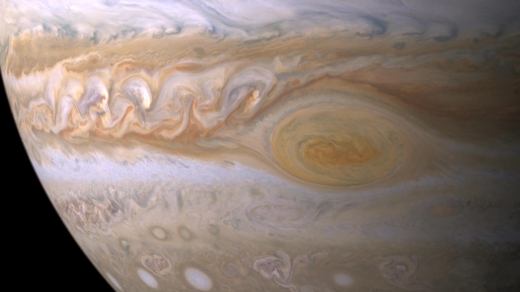
Image: Trapped between two jet streams, the Great Red Spot is an anticyclone swirling around a center of high atmospheric pressure that makes it rotate in the opposite sense of hurricanes on Earth. Credit: NASA/JPL/Space Science Institute.
The Great Red Spot is an enormous storm that, though mutable, has continued to rage for at least 150 years and perhaps much longer than that. The researchers found evidence of three layers of clouds here, with the deepest at 5-7 bars (1 bar approximates the average atmospheric pressure at sea level on Earth). This would be about 160 kilometers below the cloud tops in a region where temperature is thought to reach the freezing point of water. The Bjoraker team describes an opaque cloud layer detected at around 5 bars as ‘almost certainly a water cloud.’
What’s crucial here is the methodology, because if the methods used on the Great Red Spot can be validated by the Juno spacecraft, we can apply them to other gas giants. Now orbiting Jupiter until 2021 and conducting its own search for water using its infrared spectrometer, Juno has as a key objective the identification and characterization of atmospheric H2O, although observations using the spacecraft’s Microwave Radiometer are tricky given the low microwave absorptivity of H2O gas when compared to ammonia.
Thus we have a necessary synergy between ground-based measurements of both H2O and NH3 to support what Juno’s MWR instrument finds and to increase the accuracy of its calibration. This Clemson University news release explains that within months, the team will be collecting ‘many gigabytes’ of data with the iSHELL spectrograph that can be matched against further Juno observations, with a suite of automated software being built to analyze the results.
Getting a better picture of Jupiter’s water content could prove useful in a number of ways, and might even take us in a science fictional direction, says Clemson University co-author Máté Ádámkovics:
“The discovery of water on Jupiter using our technique is important in many ways. Our current study focused on the red spot, but future projects will be able to estimate how much water exists on the entire planet. Water may play a critical role in Jupiter’s dynamic weather patterns, so this will help advance our understanding of what makes the planet’s atmosphere so turbulent.”
True enough. And this takes us back into the imaginative realm of Clarke, Baxter and Reynolds:
“And, finally, where there’s the potential for liquid water, the possibility of life cannot be completely ruled out. So, though it appears very unlikely, life on Jupiter is not beyond the range of our imaginations.”
For those wanting to explore notions of life within Jupiter’s atmosphere, have a look at Larry Klaes’ fine essay Edwin Salpeter and the Gasbags of Jupiter, which looks at a Cornell University collaborator of Carl Sagan and the duo’s unusual musings on a Jovian taxonomy.
The paper is Bjoraker et al., “The Gas Composition and Deep Cloud Structure of Jupiter’s Great Red Spot,” The Astronomical Journal Vol. 156, No. 3 (abstract).

An Asteroid’s Tumultuous Evolution
How extraordinary that we can sometimes tell so much from so little. Extraordinary too how careful we must be to make sure we’re not reading too much into small sample sizes. All of which brings me to the Japanese Hayabusa probe, a spacecraft that survived continual mischance on its journey to asteroid 25143 Itokawa, but was somehow able to return tiny grains of surface material to Earth. And using those materials, scientists are now revealing a violent past that tells us something not only about how the asteroid formed but what happened to it long after.
The work of Kentaro Terada (Osaka University) and colleagues, the investigation follows a complicated path back to the earliest era of our system. But let’s start with the sample collection, which almost didn’t happen: Already damaged from a major solar flare not long after liftoff on May 9, 2003, Hayabusa (the word means ‘falcon’ in Japanese) would also lose two of its three stabilizing reaction wheels. And when the command to deploy its Minerva mini-lander was given, the rover was lost.
Amidst these problems, JAXA (the Japanese space agency) scientists were finally able to bring the spacecraft into contact with the surface, enough so to disturb dust grains it could store for return to Earth. This would mark the first time the surface of an asteroid could be examined in the laboratory, and a decade of this investigation is yielding insights.

Image: The Hayabusa mission returned samples from Itokawa which are giving clues to the ancient history of the unusual asteroid. Image credit: ISAS, JAXA.
Scientists haven’t had a lot of material to work with, but it doesn’t take much. Examining micrometer-sized phosphate minerals using X-ray micro-tomography, the researchers have been able to perform isotope analysis of uranium (U) and lead (Pb), the latter enabled by Secondary Ion Mass Spectrometry (SIMS). This technique uses a focused ion beam on solid surfaces that causes the ejection of secondary ions that can be measured, revealing their molecular composition. Here’s how lead author Kentaro Terada explains the methods:
“By combining two U decay series, 238U-206Pb (with a half-life of 4.47 billion years) and 235U-207Pb (with a half-life of 700 million years), using four Itokawa particles, we clarified that phosphate minerals crystalized during a thermal metamorphism age (4.64±0.18 billion years ago) of Itokawa’s parent body, experiencing shock metamorphism due to a catastrophic impact event by another body 1.51±0.85 billion years ago.”
Itokawa was indeed formed some 4.6 billion years ago, in the formation period of the Solar System, but we also learn here that its subsequent life has been anything but serene. The second event Terada refers to would likely have been a collision with another asteroid.
Useful here is the comparison between the Itokawa particles and the composition of LL (Low (total) iron, Low metal) chondrites that fall to Earth. This work shows that the formation of Itokawa’s parent body was similar to that of typical LL chondrites — their mineralogy and geochemistry bear strong resemblances — but the collision history of Itokawa, with a catastrophic event 1.4 billion years ago, is significantly different from the ‘shock’ ages of most LL chondrites. The Itokawa shock history resembles, in fact, that of the Chelyabinsk meteorite.
The team goes deeper still, as witness this from the paper:
The observation of a deceleration in the rotation rate of Itokawa also constrains Itokawa’s evolution to within the last 0.1–0.4 million years during which period the conjunction of the two parts referred to as “head” and “body” by a low velocity impact occurred. This conjunction must have occurred after the disruption event and the subsequent main re-accumulation and possibly while the Itokawa fragments still resided within the main belt.
Itokawa was, in other words, pulverized by the collision revealed in these data, eventually reforming into the object we study today over a period of time. Following several billion years in the main asteroid belt, Itokawa was ejected by gravitational resonances into its current Earth-crossing orbit. Drawing on previous work on Itokawa orbits, the authors predict that at some point within the next million years, the asteroid will collide with Earth or else break apart.

Image: Back-scattered electron images of the Itokawa particles. (A–C) Show back-scattered images of polished sections of RA-QD02-0056, RA-QD02-0031, RB-QD04-0025, respectively. (D) Shows the “simulated” slice image of RB-CV-0025 before polishing, based on X-ray microtomography. Here, the angle and depth are selected where the cross sections inside two phosphates become the largest. (E) Shows the “actual” microscope image after careful manual polishing. Most phosphate grains are on the order of 2?µm?×?4?µm to 4?µm?×?5?µm in size. Credit: Terada et al.
Much rides here on the analysis of a very small amount of material, as the paper is quick to add:
…we emphasize that our successful chronology results for Itokawa are based on a single brecciated particle, RA-QD02–0056, that includes several apatite grains. Such a brecciated grain is so fragile that it may not have been collected if the Hayabusa spacecraft sampling mechanism had operated as planned and its impactors struck the Itokawa surface.
We learn, however, that the Hayabusa team has found other particles that may include phosphorus materials, so further studies should put tighter constraints on the violent events of Itokawa’s evolution.
The paper is Terada et al., “Thermal and impact histories of 25143 Itokawa recorded in Hayabusa particles,” Scientific Reports 8, published 7 August 2018 (full text).

A Glimpse of Ultima Thule
This morning we have an image of MU69, the Kuiper Belt object to which New Horizons is heading, with arrival and flyby scheduled for January 1, 2019. This just after the first glimpse of the asteroid Bennu by the spacecraft now heading there for observation and sample return, OSIRIS-REx. By way of comparison, the first glimpse New Horizons had of Pluto/Charon came during an optical navigation test using the Long Range Reconnaissance Imager (LORRI), which occurred in September of 2006 when Pluto was still 4.2 billion kilometers away.
We knew in the year of its launch, in other words, that New Horizons could find and track targets at extremely long range, but MU69, otherwise known as Ultima Thule, is a tiny target indeed. Moreover, it’s one that raises a host of obstacles particularly in terms of the background stars. We are trying to pluck it out of field objects from a distance of 172 million kilometers.
“The image field is extremely rich with background stars, which makes it difficult to detect faint objects,” said Hal Weaver, New Horizons project scientist and LORRI principal investigator from the Johns Hopkins Applied Physics Laboratory in Laurel, Maryland. “It really is like finding a needle in a haystack. In these first images, Ultima appears only as a bump on the side of a background star that’s roughly 17 times brighter, but Ultima will be getting brighter – and easier to see – as the spacecraft gets closer.”
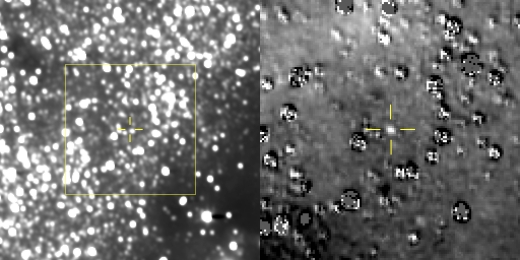
Image: The figure on the left is a composite image produced by adding 48 different exposures from the News Horizons Long Range Reconnaissance Imager (LORRI), each with an exposure time of 29.967 seconds, taken on Aug. 16, 2018. The predicted position of the Kuiper Belt object nicknamed Ultima Thule is at the center of the yellow box, and is indicated by the yellow crosshairs, just above and left of a nearby star that is approximately 17 times brighter than Ultima.
At right is a magnified view of the region in the yellow box, after subtraction of a background star field “template” taken by LORRI in September 2017 before it could detect the object itself. Ultima is clearly detected in this star-subtracted image and is very close to where scientists predicted, indicating to the team that New Horizons is being targeted in the right direction. The many artifacts in the star-subtracted image are caused either by small mis-registrations between the new LORRI images and the template, or by intrinsic brightness variations of the stars. At the time of these observations, Ultima Thule was 172 million kilometers (107 million miles) from the New Horizons spacecraft and 6.5 billion kilometers (4 billion miles) from the Sun. Credit: NASA/Johns Hopkins University Applied Physics Laboratory/Southwest Research Institute.
We are now in the process of continually setting records. These images are the most distant ever taken from the Sun, an honor that was once held by Voyager 1 in its famous ‘Pale Blue Dot’ image of the Earth, taken in 1990. New Horizons likewise snagged the award for most distant image from Earth in December of 2017. The images above were taken on August 16, a series of 48 that succeeded at the spacecraft’s first attempt to find MU69 with its own cameras. Now we can spend the next four months updating the record and watching MU69 grow.
And since ‘first glimpse’ images seem to define this week, here’s that first New Horizons image of Pluto.
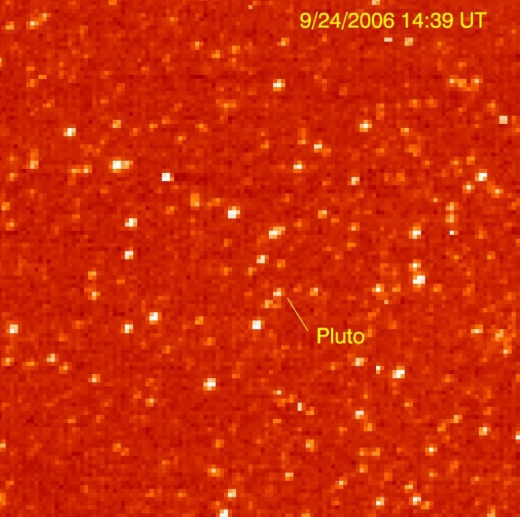
Image: The Long Range Reconnaissance Imager (LORRI) on New Horizons acquired images of the Pluto field three days apart in late September 2006, in order to see Pluto’s motion against a dense background of stars. LORRI took three frames at 1-second exposures on both Sept. 21 and Sept. 24. Because it moved along its predicted path, Pluto was detected in all six images. The images appear pixelated because they were obtained in a mode that compensates for the drift in spacecraft pointing over long exposure times. Credit: NASA/Johns Hopkins University Applied Physics Laboratory/Southwest Research Institute.
This far away from home, it seems fitting to quote from the one Edgar Allen Poe verse, ‘Dreamland,’ that mentions Ultima Thule in its incarnation as a literary figure for the most distant of Earthly places:
By a route obscure and lonely,
Haunted by ill angels only,
Where an Eidolon, named Night,
On a black throne reigns upright,
I have reached these lands but newly
From an ultimate dim Thule –
From a wild weird clime, that lieth, sublime,
Out of Space – out of Time.

